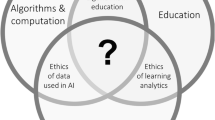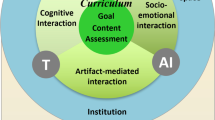Abstract
The well-being of modern economies and societies is increasingly requiring citizens to possess capabilities in integrating knowledge and skills in science, technology, engineering and science to solve problems. However, by the end of schooling, the majority of Australian students show little interest in these discipline areas and have no plans to continue study or work in them; many refer to these disciplines as boring. Further, they typically have little experience in integrating knowledge and skills from these disciplines and/or in applying this to solve relevant problems. Therefore, there is a need to engage students with such learning experiences to develop their interest and capabilities, particularly during the early years of secondary schooling. This is not easy for teachers to respond to, but with the support of modern digital technologies and the new Australian curriculum, the potential is expanded and the challenge is more readily achievable. However, appropriate pedagogies need to be supported that include more authentic approaches to assessment. Learning activities need to support students to integrate knowledge and skills across discipline areas in tackling real problems, and this also needs to be reflected in how students are assessed. In this paper, I will draw on personal experience as a teacher, a review of recent literature, components of the Australian Curriculum, and findings from research projects associated with my University research centre, to argue for, and illustrate how, teachers can orchestrate powerful learning activities to promote an interdisciplinary approach to STEM.
Similar content being viewed by others
References
Australian Curriculum, Assessment and Reporting Authority (2013) Australian curriculum. http://www.australiancurriculum.edu.au/. Accessed 20 Jan 2016
Australian Curriculum, Assessment and Reporting Authority (2015) National Assessment Program: ICT literacy years 6 and 10—Reprot 2014. Sydney: Australian Curriculum, Assessment and Reporting Authority (ACARA)
Becta (2006) The Becta review 2006: evidence on the progress of ICT in education. Becta ICT Research, London
Biagi F, Loi M (2013) Measuring ICT use and learning outcomes: evidence from recent econometric studies. Eur J Educ 48(1):28–42. doi:10.1111/ejed.12016
Blackley S, Howell J (2015) A STEM narrative: 15 years in the making. Aust J Teach Educ 40(7):102–112. doi:10.14221/ajte.2015v40n7.8
Chubb I (2015) Vision for a science nation. Department of Industry and Science. Canberra, Commonwealth of Australia, p 33
Commission Productivity (2016) Digital disruption: What do governments need to do?. Productivity Commission, Canberra, p 251
Crook SJ, Sharma MD, Wilson R (2015) Comparison of technology use between biology and physics teachers in a 1:1 laptop environment. Contemp Issues Technol Teach Educ 15(2):1–25
Deloitte Access Economics (2015) Australia’s digital pulse. Australian Computer Society, Sydney
Drigas AS, Pappas MA (2015) On line and other game-based learning for mathematics. Int J Online Eng 11(4):62–67. doi:10.3991/ijoe.v11i4.4742
EdTech Strategies, LLC (2015) Pencils down: the shift to online and computer-based testing. EdTech Strategies LLC, Arlington, pp 1–4
Fraser BJ (1994) Research on classroom and school climate. In: Gabel D (ed) Handbook of research on science teaching and learning. Macmillan, New York, pp 493–541
Freeman S, Eddy SL, McDonough M, Smith MK, Okoroafor N, Jordt H et al (2014) Active learning increases student performance in science, engineering, and mathematics. Proc Natl Acad Sci. doi:10.1073/pnas.1319030111
Grover S, Pea R (2013) Computational thinking in K-12: a review of the state of the field. Educ Res 42(1):59–69
Kafai YB, Burke Q (2013) Computer programming goes back to school. Phi Delta Kappan 95(1):61–65
Kennedy J, Lyons T, Quinn F (2014) The continuing decline of science and mathematics enrolments in Australian high schools. Teach Sci 60(2):34–45
Kessels U, Taconis R (2012) Alien or alike? How the perceived similarity between the typical science teacher and a student’s self-Image correlates with choosing science at school. Res Sci Educ 42(6):1049–1071
Kimbell R (2012) The origins and underpinning principles of e-scape. Int J Technol Des Educ 22(2):123–134
Lei J, Zhao Y (2007) Computer uses and student achievement: a longitudinal study. Comput Educ 49(2):284–296. doi:10.1016/j.compedu.2005.06.013
Lin H, Dwyer F (2006) The fingertip effects of computer-based assessment in education. TechTrends 50(6):27–31
Maheswaran R (2015) The math behind basketball’s wildest moves. http://www.ted.com/talks/rajiv_maheswaran_the_math_behind_basketball_s_wildest_moves?language=en. Accessed 20 Jan 2016
Malley A (2015) Model for the modern entrepreneur. InTheBlack. Bauer Media Group, Sydney, pp 22–26
Mann D, Shakeshaft C, Becker J, Kottkamp R (1999) West virginia story: achievement gains from a statewide comprehensive instructional technology program. Milken Exchange on Education Technology, USA
Masters GN (2013) Reforming educational assessment: imperatives, principles and challenges. In: Mellor S (ed) Australian education review. ACER Press, Melbourne
Masters GN (2015) A 21st century curriculum. [Long Reads]. Teacher. http://www.teachermagazine.com.au/geoff-masters/article/a-21st-century-curriculum. Accessed 28 Jan 2016
Myers A, Berkowicz J (2015a) The STEM shift. Corwin, Thousand Oaks
Myers A, Berkowicz J (2015b) STEM should broaden, not narrow, the curriculum. Educ Week 35(5):18
Newhouse CP (2004) Portable computing supporting project-based learning. In: Au W, Li K, White B (eds) Australian computers in education conference. Australian Council for Computers in Education, Adelaide, South Australia, pp 1–5
Newhouse CP (2013) ICT in the Australian curriculum. In: Wong L-H, Liu C-C, Hirashima T, Sumedi P, Lukman M (eds) Proceedings of the 21st International Conference on Computers in Education, Bali, Indonesia, pp 914–919
Newhouse CP (2014) Learning with portable digital devices in Australian schools: 20 years on! Aust Educ Res 41(4):471–483
Newhouse CP (2015) Measuring the meaningful use of ICT in schools: a learning environments attributes approach. Int J Tech Enhanced Learn 7(4):309
Newhouse CP, Clarkson BD (2008) Using learning environment attributes to evaluate the impact of ICT on learning in schools. Res Prac Tech Enhanced Learn 3(2):139–158
Newhouse CP, Lane J, Cooper M, Twining P (2014) Redefining education: sustaining 1 to 1 computing strategies in Western Australian schools. In: Urban S (ed) Australian computers in education conference. Australian Council for Computers in Education, Adelaide, Australia, pp 345–351
OECD (2015) Schooling redesigned: towards innovative learning systems. OECD Publishing, Paris
Office of the Chief Scientist (2014) Science, technology, engineering and mathematics: Australia’s future. Canberra
Ong T (2015) Atlassian: Sydney-based tech firm becomes most successful Australian listing on US stock exchange. ABC News, New York
Organisation for Economic Co-operation and Development (2005) Are students ready for a technology-rich world? What PISA studies tell us. Paris, p 138
President’s Council of Advisors on Science and Technology (PCAST) (2010) Prepare and inspire: K-12 education in science, technology, engineering, and math (STEM) for America’s future. White House Office of Science and Technology Policy (OSTP), Washington, DC
Prieto LP, Dimitriadis Y, Asensio-Perez JI, Looi C (2015) Orchestration in learning technology research: evaluation of a conceptual framework. Res Learn Technol 23:1–15. doi:10.3402/rlt.v23.28019
Ritz JM, Fan S (2015) STEM and technology education: international state-of-the-art. Int J Technol Des Educ 25:429–451. doi:10.1007/s10798-014-9290-z
Sanders ME (2012) Integrative stem education as best practice. In: Middleton H (ed) Explorations of best practice in technology, design, and engineering education, vol 2. Griffith Institute for Educational Research, Queensland, pp 103–117
School Curriculum and Standards Authority (2015a) WACE: applied information technology syllabus—year 11. http://wace1516.scsa.wa.edu.au/__data/assets/pdf_file/0004/10984/Applied_Information_Technology_Y11_Syllabus_ATAR_PDF.pdf. Accessed 20 Jan 2016
School Curriculum and Standards Authority (2015b). WACE: engineering studies syllabus—year 11. http://wace1516.scsa.wa.edu.au/__data/assets/pdf_file/0015/11292/Engineering_Studies_Y11_Syllabus_ATAR_pdf2.pdf. Accessed 20 Jan 2016
Stevenson I (2013) Does technology have an impact on learning? A fuzzy set analysis of historical data on the role of digital repertoires in shaping the outcomes of classroom pedagogy. Comput Educ 69:148–158
Stoilescu D (2015) A critical examination of the technological pedagogical content knowledge framework: secondary school mathematics teachers integrating technology. J Educ Comput Res 52(4):514–547
The Australian Industry Group (2015) Progressing STEM skills in Australia. The Australian Industry Group, Sydney, p 19
US Department of Education (2013) Expanding evidence approaches for learning in a digital world. US Department of Education, Office of Educational Technology, Washington, DC
Wing J (2011) Research notebook: computational thinking—What and why? In: The link magazine, spring, vol 6.0. pp 20–23
World Economic Forum (2016) The future of jobs: employment, skills and workforce strategy for the fourth industrial revolution. World Economic Forum, Geneva, pp 1–159
Author information
Authors and Affiliations
Corresponding author
Rights and permissions
About this article
Cite this article
Newhouse, C.P. STEM the Boredom: Engage Students in the Australian Curriculum Using ICT with Problem-Based Learning and Assessment. J Sci Educ Technol 26, 44–57 (2017). https://doi.org/10.1007/s10956-016-9650-4
Published:
Issue Date:
DOI: https://doi.org/10.1007/s10956-016-9650-4




